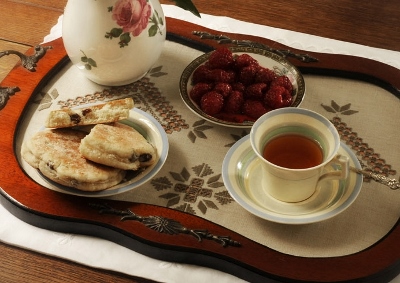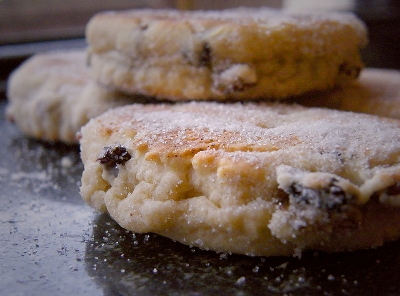Flickr/liz west
Ah, March! Guinness piled to the rafters. Corned beef in the meat case. And soda bread in the bakery. It’s the Emerald Isle in the grocery aisle.
Everyone gets a little Irish round about the middle of the month. But March 1st heralds another Celtic holy man: Welsh St. David. And St. David’s Day is becoming more popular on both sides of the Atlantic, thanks in part to the growing enthusiasm for local and seasonal foods.
This is especially true at Cwtch (substitute a ‘u’ for the ‘w’ and rhyme with “butch”) in the city named for St. David. Last year, their St. David’s Day menu celebrated fresh foods from the surrounding Pembrokeshire coast: crab, cockles, sea bass, and mackerel. National pride was expressed in the Welsh beef, Welsh lamb, and Welsh cakes.
Because St. David’s Day falls on a Sunday this year, Cwtch will stick with the tradition of their regular Sunday lunch—but with holiday influences. Owner Jackie Hatton-Bell sets the menus only a few days in advance, but she’d “be surprised if we didn’t feature leeks.”
The leek is to St. David what the shamrock is to St. Patrick. Botany, luck, and legend. In a sixth-century battle against the Saxons, St. David convinced his followers to proudly wear the local veg in their hats to distinguish themselves from the foreign enemy. And that was the key to victory. Or at least that’s how the story goes.
For Hatton-Bell, leeks are “a staple vegetable, but not just for St. David’s Day.” It’s less a matter of national symbols and more about Cwtch’s passion for local suppliers. “We have such a wonderful larder on our doorstep,” she says. “We’d be bonkers not to use it.”
That natural Welsh larder is showcased at the annual cawl competition hosted by St. David’s City Council. Cawl (rhymes with owl) is a Welsh stew perfect for spring. “Normally you would pop a leek in the cawl” along with potatoes, carrots, and, of course, Welsh lamb, says Heidi Gray, City Council Clerk.
Every year, for the past ten years, local restaurants and caterers have brought their best cawls to be judged. Anyone can come and taste and vote. “Whoever gets the most votes is awarded the coveted golden ladle for the year,” says Gray. This year it was the café in the Oriel Y Parc National Visitor’s Centre.
Gray wants to make the celebrations “a bit more dramatic and a bit more modern.” That’s perhaps what’s needed to help it compete against the March festivities across the Irish Sea—as well as across the Atlantic.

© Crown copyright (2015) Visit Wales
In Chicago, St. Patrick’s Day is so important that they turn the city’s main waterway green for the week. Luckily there’s the Chicago Tafia —a blend of “taffy” (once a derogatory word for someone from Wales) and “mafia.” “Pretty much anything that’s Welsh that’s going on in the city, we have a hand in,” says Welsh expat and Tafia founder David Parry. They’re the force behind lighting the Wrigley Building in the red, green, and white hues of the Welsh flag. And if you join them for St. David’s Day feast, their website promises “some rather damn fine Cawl and whiskey trifle” made by chef Sue Barton at Lincoln Square’s Red Lion pub.
Cawl is “an obvious choice” at New York’s Longbow Pub and Pantry, according to owner Michael Colbert from Wrexham in North Wales. “We put on a Welsh menu. Welsh food, Welsh cakes, Welsh scones.”

Flickr/zingyyellow
Priding themselves on being the only Welsh pub in New York, Longbow makes their Welsh food made in-house. “We have recipes from traditional Welsh books and if we can find anything authentic in Wales, we put it in there,” says Colbert. The only thing that isn’t made in-house, of course, is the Welsh whisky Longbow serves.
Access to a national drink is perhaps one reason why the love of St. Patrick proliferates so easily. You can pick up a 6-pack of Guinness or Harp, but getting Welsh beer in the US is “next to impossible” admits Parry.
Instead, the Chicago Tafia demonstrate the same investment to local food and drink as their compatriots back in Wales by drawing on Welsh-inspired products from the Midwest and nearby states. They drink Gale’s cider, described by the Thomas Family Winery that has been making it in Madison, Indiana for 90 years as “a strong, dry cider the old Celts would have been proud of.” Also, there’s Evan Williams’ Kentucky Bourbon that still brags its Welsh roots.
But in D.C. the holiday drink of choice at the century-old St. David’s Society is wine. It’s a city with “a fairly affluent clientele,” says the society’s communications director, Katherine De Francis. Therefore, the St. David’s Day dinner is “very consciously on the high end” at $100 a plate. Not surprisingly, it’s more about the politics than the food. This is the place where Virginia Republican Morgan Griffith launched the Friends of Wales Caucus to support Welsh business and tourism.
While the Washingtonian St. David’s Society won’t be dining on Welsh cheeses or cawl, there will still be plenty of Welsh music with an award-winning harp player. And of course, leeks. It’s not on the usual menu of the Cosmo Club where the dinner is held, but, “they do our potato and leek soup,” says De Francis. “That is specially for us.”

© Crown copyright (2015) Visit Wales
Anne Bramley is a writer and independent scholar living in Norwich, UK. She’s the author of Eat Feed Autumn Winter and the first woman to create a food podcast, Eat Feed, which Saveur called “the finest way to take your food on the road.” Twitter: @eatfeed